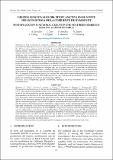Por favor, use este identificador para citar o enlazar este ítem:
https://hdl.handle.net/20.500.12958/4879| Título : | Grupos funcionales del fitoplancton en el norte del ecosistema de la Corriente de Humboldt |
| Otros títulos : | Phytoplankton functional groups in the Northern Humboldt Current Ecosystem (NHCE) |
| Autor : | Bernales Jiménez, Avy Tam Málaga, Jorge Sánchez, Sonia Jacobo, N. Chang, Flor Delgado Loayza, Elcira Romero, Liz Demarcq, Hervé |
| Palabras clave : | Fitoplancton;Grupos funcionales;Estrategias de vida;Ecosistema de Corriente de Humboldt |
| Fecha de publicación : | jun-2022 |
| Editorial : | Instituto del Mar del Perú |
| Citación : | Bernales, A., Tam, J., Sánchez, S., Jacobo, N., Chang, F., Delgado, E., Romero, L., Demarcq, H. (2022). Grupos funcionales del fitoplancton en el norte del ecosistema de la Corriente de Humboldt. Bol Inst Mar Perú. 37(1): 51- 76. |
| Citación : | Boletín IMARPE 37(1), 2022; |
| Resumen : | El Norte del ecosistema de la Corriente de Humboldt, localizado a lo largo del Sudeste del Océano Pacífico, frente a Perú, es considerado uno de los más productivos sistemas naturales en el mundo, siendo de gran relevancia el estudio del fitoplancton como base de la trama trófica marina. Tomando en cuenta las relaciones entre la superficie celular, biovolumen y máxima dimensión lineal de las células de las especies del fitoplancton, se encontraron 140 especies en el grupo funcional ‘R‘ (especies ruderales, adaptables a condiciones altas de mezcla); 133 especies en el grupo funcional ‘S’ (especies Stress-tolerantes, predominantes en condiciones oligotróficas y de alta luz) y 19 en el grupo funcional ‘C’ (especies colonizadoras, oportunistas, predominantes en condiciones mesotróficas y de alta luz). En el grupo funcional R destacaron las diatomeas elongadas, pennadas, dispuestas en cadenas; en el grupo funcional S se encontraron dinoflagelados, diatomeas centrales grandes y silicoflagelados; mientras que, en el grupo funcional C destacaron cocolitofóridos, algunos dinoflagelados mixotróficos y fitoflagelados. Los porcentajes de coincidencia entre la clasificación morfométrica de grupos funcionales del presente estudio y la clasificación ecológica, estuvieron entre 52 y 90%. Se propone el uso de estos grupos para evaluar las variaciones espacio-temporales del fitoplancton y su relación con las condiciones ambientales en el Norte del ecosistema de la Corriente de Humboldt, cuyos niveles de turbulencia son menores al de los fiordos chilenos. ABSTRACT: The Northern Humboldt Current ecosystem (NHCE), located in the southeastern Pacific off Peru, is one of the most productive natural systems worldwide. This area is of great relevance for the study of phytoplankton as the basis of the marine trophic web. Based on the relationships between the cell surface area, biovolume, and maximum linear dimension of the cells of the phytoplankton species, we found 140 species in the functional group ‘R’ (ruderal species, which are adaptable to high mixing conditions); 133 species in functional group ‘S’ (Stress-tolerant species, predominant in oligotrophic and high light conditions), and 19 species in functional group ‘C’ (colonizing, opportunistic species, predominant in mesotrophic and high light conditions). These three functional groups (FGs) are respectively formed by elongated, pennate, and chain-forming diatoms (group R); dinoflagellates, large central diatoms, and silicoflagellates (group S), and coccolithophores, some mixotrophic dinoflagellates, and phytoflagellates (group C). The percentages of coincidence between the morphometric classification of the FGs of this study and the ecological classification were between 52% and 90%. We propose the use of FGs to evaluate the spatio-temporal variations of phytoplankton and its relation with environmental conditions in the NHCE, whose turbulence levels are lower than those recorded in Chilean fjords. |
| URI : | https://hdl.handle.net/20.500.12958/4879 |
| ISSN : | 04587766 |
| Aparece en las colecciones: | Boletín 37(1) 2022 |
Ficheros en este ítem:
| Fichero | Descripción | Tamaño | Formato | |
|---|---|---|---|---|
| Boletin 37-1 artículo 4.pdf | 697,51 kB | Adobe PDF |  Visualizar/Abrir |
Este ítem está sujeto a una licencia Creative Commons Licencia Creative Commons

